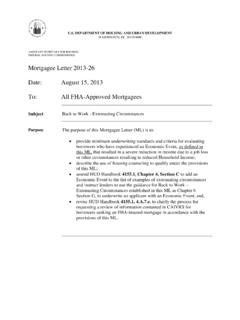Transcription of The National Voter Registration Act of 1993: History ...
1 CRS Report for CongressPrepared for Members and Committees of Congress The National Voter Registration Act of 1993: History , Implementation, and Effects Royce Crocker Specialist in American National Government September 18, 2013 Congressional Research Service 7-5700 R40609 The National Voter Registration Act of 1993: History , Implementation, and Effects Congressional Research Service Summary After the passage of the Voting Rights Act of 1965 (42 1973 1973aa-6), legislation had been urged for over two decades that would create a National Voter Registration system designed to make Registration easier and more uniform from state to state. The National Voter Registration Act of 1993 (NVRA, 103-31, 107 , [42 1973gg et seq.)]
2 ]), the so-called motor- Voter bill, was signed into law by President Clinton on May 20, 1993. It required states to establish Voter Registration procedures for federal elections so that eligible citizens might apply to register to vote (1) simultaneously while applying for a driver s license, (2) by mail, and (3) at selected state and local offices that serve the public. The law took effect on January 1, 1995, for most states. Proponents argued that the NVRA would make it easier to register to vote, provide more-than-adequate measures to prevent Voter fraud by making violations a federal offense, and cost states very little to implement, based on the experiences of states that previously used some form of motor- Voter Registration .
3 Opponents, on the other hand, argued that there was little evidence that increasing the number of persons on Voter Registration rolls would lead to higher Voter turnout. By making it so easy to register, they believed the act would increase the likelihood of election fraud. Furthermore, according to opponents, implementation would be costly to the states, in terms both of dollars and other administrative costs. The NVRA has been the law of the land for over 20 years and has been in effect for 18 years. Between 1992 and 2012, Voter Registration increased nationally by over seven percentage points. The courts have resolved many of the initial issues. A review of the required NVRA reports appears to indicate that the states have come to terms with the provisions, despite the fact that they would still like the federal government to provide funding for the implementation of aspects of the act.
4 While amending parts of the NVRA in minor ways, the Help America Vote Act, passed in 2002, also created additional Voter Registration demands on the states (HAVA, 107-252 [42 , Subchapter III, Part A., 15482(a), 15483]). However, there are still some problems with implementation at the local levels and in some selected state agencies, as well as with the training of non-election officials who are responsible under the NVRA for providing Voter Registration services. Some would like to curtail parts of the NVRA. Some do not think the NVRA has gone far enough. Proposed legislation introduced in the 113th Congress to deal with various aspects of the Voter Registration process includes, among others, 12, 97, 280, 289, and 2115.
5 This report provides an historical background for Voter Registration reform and the NVRA, a description of the major aspects of the act, a discussion of the implementation and post-implementation actions, and a catalog of subsequent efforts to amend or repeal the act. It will be updated as needed. The National Voter Registration Act of 1993: History , Implementation, and Effects Congressional Research Service Contents Recent Events .. 1 Background .. 1 National Voter Registration Reform .. 2 The National Voter Registration Act of 1993: Major Provisions .. 3 The Issues, Pro and Con .. 6 Voter Turnout .. 6 Voting Rights .. 6 Costs of Implementation .. 7 Election Fraud .. 9 NVRA Implementation.
6 10 The Federal Response .. 10 Development of the Mail Voter Registration Form .. 10 Biennial NVRA Report Findings .. 11 Department of Justice Activity .. 19 The Response of the States .. 21 The Response of the 22 The Congressional Response Post-NVRA .. 25 Concluding Observations .. 27 Figures Figure 1. Percentage of Voter Registration : 1992-2012 .. 23 Figure 2. Percentage Voter Turnout, Presidential Elections: 1980-2012 .. 25 Ta b l e s Table A-1. Percentage Voter Registration : 1992-2012 .. 28 Table A-2. Voter Turnout: 1980-2012 .. 30 Appendixes Appendix A. Supporting Tables .. 28 Appendix B. Post-NVRA Voter Registration Legislative History , 104th to 111th Congresses .. 32 Contacts Author Contact 36 The National Voter Registration Act of 1993: History , Implementation, and Effects Congressional Research Service 1 Recent Events On June 30, 2013 , the Election Assistance Commission released the 10th biennial report on the impact of the National Voter Registration Act of 1993 on the 2011-2012 election cycle.
7 On June 17, 2013 , the United States Supreme Court, by a vote of 7-2, held that the National Voter Registration Act of 1993 preempts the state of Arizona law requiring proof of citizenship as part of the Voter Registration process for those individuals using the Federal Form, Arizona, et. al. v. The Inter Tribal Council of Arizona, Inc. et. al., No. 12-71, June 17, On June 4, 2013 , the House Committee on House Administration held a hearing on the Voter Registration Efficiency Act ( 2115). The bill is intended to reduce the number of voters registered in multiple states, among other things. The bill would amend the National Voter Registration Act of 1993 to require individuals registering to vote in a state to indicate if the state will be the individual s residence for the purpose of voting and for other purposes.
8 Background Efforts to establish a National Voter Registration system followed closely on the heels of passage of the Voting Rights Act in 1965. In the early 1970s, a substantial effort was made to establish a National postcard or mail Registration system. In the 92nd Congress, both the Senate and the House held hearings on a proposal to establish a National Voter Registration system, with the Census Bureau conducting postcard Registration for federal elections. The proposal came to the Senate floor for a vote but was tabled. In the 93rd Congress, both the Senate and the House again considered much the same proposal; a National postcard Voter Registration system, administered by a new National Voter Registration Administration located in the Census Bureau.
9 The Senate passed the bill (S. 352, S. Rept. 93-91) on May 9, 1973 (vote: 57-37). The House, on May 8, 1974, refused to take up the bill ( 8053, H. Rept. 93-778) to establish a National postcard Voter Registration system by rejecting the rule under which the measure was to be debated on the floor (vote:197-204). In 1975, the House passed a modified version of the postcard Voter Registration measure, eliminating the required mass mailing of postcards to every household; the postcards were to be made available at post offices and other public offices ( 11552; August 9, 1975, H. Rept. 94-798, vote: 239-147). The measure, however, stalled in the Senate. During the first year of the Carter presidency, reform efforts focused on passage of a National Voter Registration standard that would have allowed citizens to register to vote on election-day ( 5400, H.)
10 Rept. 95-318). Although the proposal initially received strong support, negative reactions from local election officials appear to have caused support to erode. The House version never came up for a vote on the floor. Like the House version, the Senate bill (S. 1072, S. Rept. 95-171) was reported out of committee but never came up for a vote. By mid-1977, election-day Voter Registration was essentially defeated, and there was little or no effort to revive it for the rest of the Carter presidency. 1 For a detailed discussion, see CRS s Legal Sidebar, Supreme Court Rules: Arizona Law Requiring Proof of Citizenship for Voter Registration Preempted by Federal Law, by Paige Whitaker, The National Voter Registration Act of 1993: History , Implementation, and Effects Congressional Research Service 2 Between 1983 and 1988 various measures to reform Voter Registration were proposed.












